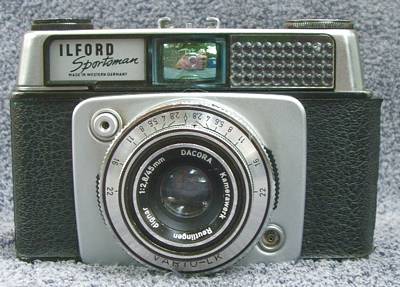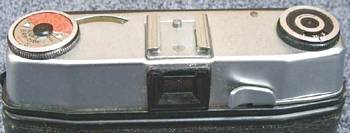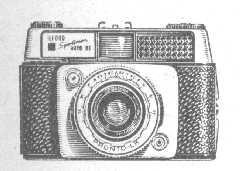| Style 4 Sportsman Auto & Auto Rangefinder; Spring 1962 |
 |
The Sportsman Auto shown alongside is by kind permission of Dan Dotson and Marilyn Saul of D'Antiques Ltd at: http://www.dantiques.com |
||
|
On the back cover of Amateur Photographer (AP) magazine dated 7th March 1962, Ilford announce 'Coming Soon.....3 exciting new cameras'. Then, in AP for 30th May 1962, on page 9, a Westminster Photographic advert describing the "New Range of Ilford 35mm Cameras". This 'New' for spring 1962 camera range consisted of the Sportsman Auto, the Sportsman Auto Rangefinder and the Sportsmaster Manumatic. The range is based upon the 1960 (4th) body style. The exposure counter is still a protruding dial on the left hand end of the top plate (viewed from the front) and film rewind is by means of a similarly protruding knurled knob at the right hand end. It is likely that all the simpler (non-rangefinder) Sportsman versions also took on the Style 4 appearance in spring 1962. The Focal Guide describes the Sportsman Auto as having "a photoelectric exposure meter built into the camera on the matching needle principle". The meter needles are visible in the top of the viewfinder and in the top plate of the camera. The light sensitive cell is a selenium type which generates its own (small) electrical voltage depending upon the light intensity. These cameras pre-date the use of cadmium sulphide (variable resistance) light sensitive cells that require a battery. The CDS cell eventually appeared in the Ilford Electrics range. Although the selenium cell requires no battery, its low voltage output requires a delicate galvanometer movement, more prone to failure. |
|||
 |
The user operates the camera by selecting a shutter speed on the lens barrel and then turns the aperture ring until a red needle coincides with the (selenium cell driven) white needle in the cut out on the (LHS) camera top plate or in the rectangular green field visible in the top of the viewfinder. | ||
|
The Focal Guide (April 1964 edition) claims that the shutter is a Pronto LK giving speeds of 1/15, 1/30, 1/60, 1/125, 1/250, 1/500 and B. However, the Sporstman Auto shown above clearly has its shutter labelled Vario LK. Also, some later models seem to have their shutters labelled as Prontor 500LK, but since the Pronto LK already runs to 1/500th sec it may be there is little practical difference. There is a built-in self-timer delayed action (at least with the later shutters but maybe not with the Vario LK) and 'X' flash synchronisation (for electronic flash at all speeds, bulbs at 1/30). The Focal Guide describes the lens as a Cassar f2.8 45mm 3-element but, as with the shutter, the above picture disagrees with the Focal Guide, showing a Dacora Dignar f2.8 45mm. Perhaps the above picture is of an early Sportsman Auto, with the Pronto / Prontor LK shutters and Cassar lens fitted by 1964? Within the AP May 1962 advert, the Sportsman Auto is priced at £27.11s.10d = £27.59p, with the ever ready case £3.1s.11d = £3.10p extra. By mid-1963 the Auto is on sale, as a shop clearance sale item, at £22.10s = £22.50p. |
|||
 |
The Sportsman Auto Rangefinder (only shown here as it appeared in a b&w advertisement) follows the same arrangement as the Auto except for it also having a fully coupled rangefinder i.e. the split image is visible in the viewfinder window and aligning the spilt image simultaneously focusses the lens. Within the AP May 1962 advert, the Sportsman Auto Rangefinder is priced at £31.16s.1d = £31.80p, with the ever ready case £3.1s.11d = £3.10p extra. By mid-1963 the Auto Rangefinder is on sale, as a shop clearance sale item, at £24. | ||
|
|
|||
|
|
|||